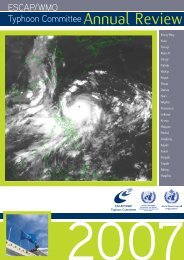TCAR - Typhoon Committee
TCAR - Typhoon Committee
TCAR - Typhoon Committee
Create successful ePaper yourself
Turn your PDF publications into a flip-book with our unique Google optimized e-Paper software.
<strong>TCAR</strong><br />
CHAPTER 5 - RESEARCH FELLOWSHIP TECHNICAL REPORT<br />
Study on<br />
Improvements in CMA’s <strong>Typhoon</strong> Track Prediction Model<br />
with Vortex Initialization Scheme<br />
Chatchai Chaiyasaen 1 and Nguyen Thi Minh Phuong 2<br />
1. Thai Meteorological Department (TMD)<br />
4353 Sukhumvit Road, Bangna, Bangkok 10260, Thailand<br />
Tel : 662-7445442, Fax : 662-7445441<br />
Mobile : 081 6461381<br />
Email : chatchai@tmd.go.th<br />
2. National Center for Hydrometeorological Forecast of Vietnam (VNCHMF)<br />
No 4 DANG THAI THAN, HANOI, VIETNAM.<br />
Email : ntmphuong@yahoo.com.au, ntmphuong@hotmail.com<br />
Abstract<br />
In China Meteorological Administration (CMA) a<br />
limited area operational numerical typhoon track<br />
prediction model (LTCM) with axisymmetric<br />
vortex bogus scheme was developed in 1992 and<br />
run operationally since 1996 . Model forecast<br />
results served as guidances for forecasters in<br />
issuing official typhoon track forecasts. Forecast<br />
verification for 1996 – 2002 showed that the<br />
mean position errors are approximately 180 km<br />
and above 350 km for +24h and +48h forecasts,<br />
respectively.<br />
Since that time both model and vortex initialization<br />
scheme are improved continuously for providing<br />
more accurate track forecasts. In 2004 in<br />
CMA the global spectral model (GSM) at T213<br />
resolution with 31 vertical levels (T213L31) named<br />
GMTTP (Global Model for TC Track Prediction)<br />
had been run operationally in paralell with LTCM.<br />
The new forecast system included a number of<br />
improvements in both model and bogus vortex<br />
initialization scheme with vortex asymmetric<br />
component that provided significant improvements<br />
in tropical storm (TS) track prediction accuracy.<br />
The performance of GMTTP for 2004 – 2005<br />
is better than those of LTCM in 14.7%, 14.0%,<br />
16.2% and 23.5% for +12h, +24h, +36h and +48h<br />
forecasts respectively. This TS prediction system<br />
GMTTP was put on operational use in 2004 to<br />
replace LTCM. Next improvement in CMA’s TS<br />
prediction system is improving vortex initialization<br />
by vortex modification and data simulation system<br />
upgrading (the OI system was replaced by the SSI<br />
3-Dvar system). The track forecast verification for<br />
2006 showed that the improved forecast system<br />
reduced average track errors of 12 - 23% in +12h<br />
to 120h forecast periods. The last system had been<br />
put into operational work in 2007 sofar.<br />
This study aimed firstly to analyze some model’s<br />
typhoon track results for typhoons of complicated<br />
tracks in Western North Pacific (WNPAC) during<br />
2006 – 2009 to consider model forecast skills and<br />
to find model’s systematic errors and bias, then<br />
conducting numerical experiments for typhoon<br />
(TY) PARMA (0917) and TY FENGSHEN (0806)<br />
by using CMA’s global spectral model and vortex<br />
initialization scheme with last improvements and<br />
modifications.<br />
1. Introduction<br />
Since 1992 in China Meteorological Administration<br />
(CMA) a limited area operational numerical<br />
typhoon track prediction model (LTCM) with<br />
axisymmetric vortex bogus scheme was<br />
2009<br />
279

















